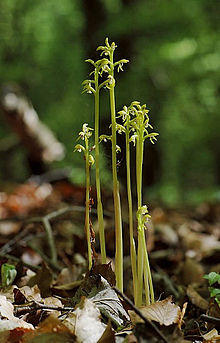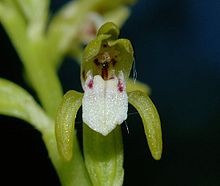Corallorhiza trifida
Appearance
| Corallorhiza trifida | |
|---|---|

| |
| Scientific classification | |
| Kingdom: | |
| (unranked): | |
| (unranked): | |
| Order: | |
| Family: | |
| Subfamily: | |
| Genus: | |
| Species: | C. trifida
|
| Binomial name | |
| Corallorhiza trifida | |
| Synonyms[1] | |
| |
Corallorhiza trifida, commonly known as early coralroot, northern coralroot, or yellow coralroot, is a coralroot orchid native to North America and Eurasia, with a circumboreal distribution. The species has been reported from the United States, Canada, Russia, China, Japan, Korea, India, Nepal, Kashmir, Greenland, Pakistan, and almost every country in Europe.[2][3][3][4][5][6][7][8][9]
Description
Corallorhiza trifida is yellowish green in color, leafless, and partially myco-heterotrophic, deriving some, but not all of its nutrients from association with fungi of genus Tomentella.[10] It also contains chlorophyll, with which it supplies some of its own carbon nutrition via autotrophy.[10]

References
- ^ "Corallorhiza trifida". World Checklist of Selected Plant Families. Royal Botanic Gardens, Kew – via The Plant List. Note that this website has been superseded by World Flora Online
- ^ Kew World Checklist of Selected Plant Families
- ^ a b Gleason, H. A. & A.J. Cronquist. 1991. Manual of the Vascular Plants of Northeastern United States and Adjacent Canada (ed. 2) i–910. New York Botanical Garden, Bronx.
- ^ Magrath, Lawrence K.; Freudenstein, John V. (2002). "Corallorhiza trifida". In Flora of North America Editorial Committee (ed.). Flora of North America North of Mexico (FNA). Vol. 26. New York and Oxford: Oxford University Press – via eFloras.org, Missouri Botanical Garden, St. Louis, MO & Harvard University Herbaria, Cambridge, MA.
- ^ Chen, Xinqi; Gale, Stephan W.; Cribb, Phillip J. "Corallorhiza trifida". Flora of China. Vol. 25 – via eFloras.org, Missouri Botanical Garden, St. Louis, MO & Harvard University Herbaria, Cambridge, MA.
- ^ Böcher, T. W. 1978. Greenlands Flora 326 pp.
- ^ Porsild, A. E. & W. Cody. 1980. Checklist of the Vascular Plants of the Northwest Territories Canada i–viii, 1–607. National Museum of Natural Sciences, Ottawa.
- ^ Tolmatchev, A. I. 1963. Arkticheskaia Flora SSSR 4: 1–96.
- ^ Flora Italiana, Corallorhiza trifida Chatel.
- ^ a b Zimmer, K., et al. (2008). The ectomycorrhizal specialist orchid Corallorhiza trifida is a partial myco-heterotroph. New Phytologist 178:2 395-400.
External links
Wikimedia Commons has media related to Corallorhiza trifida.
Wikispecies has information related to Corallorhiza trifida.
- Jepson Manual Treatment - Corallorhiza trifida
- USDA, NRCS (n.d.). "Corallorhiza trifida". The PLANTS Database (plants.usda.gov). Greensboro, North Carolina: National Plant Data Team.
